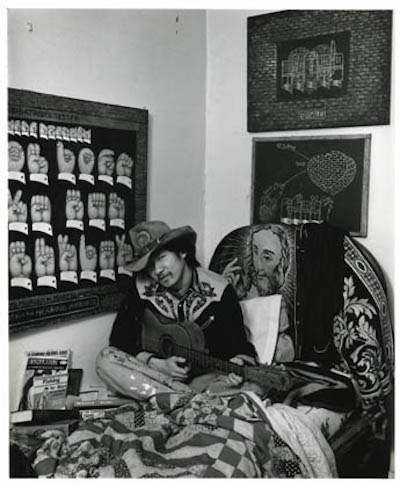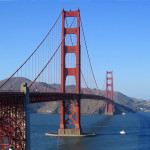 |
| Martin Wong in 1985. Photo by Peter Belamy. Courtesy of the Estate of Martin Wong and P.P.O.W Gallery, New York |
Martin Wong: Painting Is Forbidden is a solo exhibition dedicated to the work of Chinese-American artist Martin Wong (1946-1999) curated by the California College of Art’s graduate program in curatorial practice class of 2015. The exhibition encompasses writing, calligraphy, drawing, ceramics, theatrical set design, painting, poetry, and collage. Wong is known primarily for the paintings he produced while operating in the dynamic subcultures of the Nuyorican poets and graffiti artists of 1970s and 1980s New York City. Prior to this interlude in his life, Wong, who grew up in San Francisco and studied in Eureka, California, had already produced a wild and curious body of work. He was a prolific poet and ceramicist, a psychedelic painter, an artistic collaborator in the radical communal theater of the Angels of Light, and a self-described “Human Instamatic.” Here, Visual AIDS interviews Katy Crocker and Ralph Vázquez-Concepción, two of the exhibition’s co-curators, about the new light the exhibition sheds on Wong’s wide-ranging practice.
Martin Wong: Painting Is Forbidden runs through April 18 at the CCA Wattis Institute of Art’s Kent and Vicki Logan Galleries in San Francisco.
Can you describe the curatorial selection process that inspired the exhibition on Martin Wong?
Crocker: The curatorial selection process for the CCA graduate thesis exhibition attempts to mimic standard submission practices at museums. Student curators submitted proposals to a review committee, including the Wattis Institute, as well as the department chair of the curatorial practice program, Leigh Markopolous and Julian Myers-Szupinska. One student, Dincer Sirin, spent the summer of 2013 independently researching Martin Wong at the Fales Library at New York University. His proposal began with the general premise of a solo exhibition of Martin Wong, and was selected by the committee.
While Martin Wong: Painting Is Forbidden is a solo exhibition, it is not entirely accurate to describe the exhibition as monographic. The exhibition also contains works that Martin made collaboratively with the experimental performance commune Angels of Light in San Francisco; including several photographs of performances in the 1970s, as well as two masks worn during performances.
In what ways does the exhibition shed new light on Wong’s varied artist practice?
Crocker: In 1964, Martin enrolled in the art department at Humboldt State University in Eureka, California. He studied and made art in Northern California for over a decade before moving to New York. Yet much of the work Martin made in California has not been exhibited. In Eureka, Martin developed the Human Instamatic series, created countless ceramic objects, constructed elaborate set designs and costumes with the Angels of Light, and published his first book of poems, Footprints, Poems, and Leaves (1968). The earliest drawing in our exhibition dates from 1963, “Portrait of Arthur Rimbaud.” However, Martin is predominantly known for the paintings he produced while living in New York (1978-1995). Simply by focusing our research on an earlier moment of the artist’s practice, our curatorial team discovered a curious, cross-disciplinary body of work.
Ralph Vázquez-Concepción: Painting Is Forbidden also presents these in a manner that you can interpolate many of the themes he explored across multiple media. Our exhibition design aims to capture the eye, and keep it bouncing across the gallery--ricocheting across the room, as curator Julie Ault mentioned during her visit prior to the opening. Ault is a curator who worked closely with Martin, and has written extensively about his work--and she is one of the lenders for our exhibition as well.
It’s particularly exciting to show Wong’s work in his hometown of San Francisco. In what ways did San Francisco and Humboldt State inform Wong’s work, and have there been any interesting anecdotes during the course of the exhibition that relate to the Bay Area context of the exhibition?
Crocker: The time that Martin spent working in Northern California, especially Eureka, is marked by experimentation within, and across mediums. Martin’s ceramic instructor at HSU, Lou Marak, a contemporary of Peter Voulkos, recalls a young artist who expressly broke the mechanical rules of making art. Peggy Dickinson, a classmate of Martin’s, remembers large slabs of clay pulled from the presses in the studio, and him following closely behind stamping letters into the slab. Martin would fire ceramics incorrectly, which would somehow remain intact--he would engineer things incorrectly, which would still stand.
Martin’s experimental attitude also traversed other art practices from calligraphy to painting. Similar to his artistic inclinations with ceramics, Martin adopted the basic tenets of a Gothic-style calligraphic font, and then altered the form, ultimately individuating the script. Martin filled sketchbooks, scrolls, and loose paper sheets with his personalized fonts. His early paintings reiterate the freeform line work of his scripts with hints of psychedelia, as in “Untitled (Diner Menu)” and “Untitled (Living Room),” painted in the early 1970s. Both Martin’s early paintings, and calligraphic scrolls reflect feverish, obsessive hands constantly at work.
Also during this time Martin briefly worked as a courtroom illustrator in Eureka. This coincided with his Human Instamatic series, in which he quickly sketched the likeness of human faces, and sold the drawings for a few dollars. Martin drew hundreds of these portraits, dubbing himself the “human instamatic.” Later New York-era paintings reflect Martin’s early fascinations with headline news, media, and the criminal justice system such as “Courtroom Shocker” (1983), “As Seen on TV” (1981), and “Come Over Here Rockface” (1994).
Martin was a multiplier of sorts. He “mass produced” his art by hand by using tools, including dual-headed paintbrushes, American Sign Language letter form transparencies and a sets of letter stamps. He was also a collector of things--lunch boxes, antiques, rubber ducks and baby doll faces. However, he also collected intangible things like artistic practices, and techniques and people. Painting Is Forbidden gathered the artist’s wide-ranging body of work in one room, and in so doing, and perhaps more importantly, reunited Martin’s community of friends, and family in San Francisco, the artist’s home.
New York audiences perhaps know Wong best for his figurative paintings of prison inmates and Lower East Side tenement living as well as his involvement in the graffiti scene. What are some of the more exciting additional materials from the exhibition, which encompasses mediums such as writing, calligraphy, ceramics, theatrical set design and poetry?
Vázquez-Concepción: In Painting Is Forbidden we are including archival material from private lenders and the Fales Archive, as we mentioned, and in these sources we discovered sketches for murals and paintings, sketches of friends (and lovers) like the poet Miguel Piñero--who was involved with the original Nuyorican poets’ scene in New York City--and even letterhead for Wong’s proposed Museum of American Graffiti. Among these materials, we discovered photographs and preparatory drawings for work like Martin’s “Self Portrait Mural” (1989) at the Lesbian, Gay, Bisexual & Transgender Community Center of New York City (recently restored, so go by and see it!), and we have a treasure trove of previously unseen ceramic works and paintings Wong produced while in Northern California in the ’60s and ’70s. As mentioned above, we also included photographs and masks that were used by the performance troupe the Angels of Light, of which Wong was a part of, and also drawings for posters he did for The Cockettes, another group of performers.
Our cohort wanted to cover as much of his practice as we could, and spent a great deal of time selecting the material that to us most clearly expressed his multiple aesthetic interests and modes of production. His poetry is what really struck me--it is their content that in my opinion captured his aesthetic preoccupations best, and foreshadowed many avenues he would later explore in his art in other media.
Crocker: Several members of the cohort also responded to Martin’s scrolls and calligraphy. As well, Martin’s photo-collages are worth mentioning. He would take a series of photographs of a location, and place several photographs together using masking tape in an asymmetrical arrangement. He then used these “photo-stitched” collages as reference to paint the documented locations. Finally, some of the masks Martin made in collaboration with the Angels of Light are spectacular.
Do you have a sense of the ways in which HIV/AIDS during the 1980s and after changed the trajectory of Wong’s artwork?
Vázquez-Concepción: In an essay written by curator Yasmine Ramírez titled “La Vida: The Life and Writings of Miguel Piñero in the Art of Martin Wong” she explains that Martin’s New York paintings were often portraits of friends, and he made these in order to “protect himself against further loss.” I think we all agree with Ramírez, although he did portraiture since his human instamatic days in California.
The acknowledgement of death was present in Martin’s work since the the ’60s and ’70s--in fact much of his early poetry expresses this overtly. Martin must have struggled seeing his world torn asunder by the storm that the ’80s and ’90s were to the gay community of both New York and San Francisco--and with his own disease--but what is evident is that there was an incredible sense of community that was right there with him going through this. He was never alone, this is clear, nor was he in any way diminished by the knowledge of his illness, with which he lived for many years.
One of the things that most struck our research team was the jovial disposition Martin expressed in a short video the artist Charles Ahearn made of him painting in his studio and walking about Chinatown. It was shot in the mid-’90s, and Martin looks very thin, yet still he smiles with an almost electric quality, and even flirts with the viewer, making one feel the discordance between his fading health and his lively persona. The video was dramatic to watch, as we all had at that point established an emotional relationship with Martin’s image and charm, but it is evidence of what we stated before--his body and his health was going in one direction and his soul went in exactly the opposite way.
We would love to hear more about the poetry séance that you have planned for one of the related programs for the exhibition.
Crocker: The intention of the séance and poetry reading is to metaphorically resurrect the artist through the performance of reading the artist’s poems. The Angels of Light, visiting poets to the California College of the Arts, and members of the LGBT community will honor the memory of the artist by reciting a selection of Martin’s poems. Painting Is Forbidden includes several long-form, poetry-filled scrolls, portions of which might otherwise go unread in the exhibitionary framework. The séance gives our audience a quieter moment to listen to and interpret the words of the artist. The séance and poetry reading will be held at the Wattis Institute on April 18.
What do you hope viewers of Martin Wong: Painting Is Forbidden will take away from the exhibition?
Vázquez-Concepción: We hope that the public takes away a sense of intimacy with this artist, since this is the first retrospective effort to be undertaken in the Bay Area, and we wish to open up a dialogue about his work produced both here in California and in New York. We want people to begin to understand Martin as bicoastal, and neither being an expressly East nor West Coast artist, or let him get caught up in the muddle of who is from where and why. We think framing his legacy in this manner is not useful, and a bit shortsighted.
We want people to see an artist who was not stopped by his AIDS-related illness, and who continued to produce work, and to cultivate deep relationships with those around him all through his life until he could do so no more. We all fell in love with Martin’s work, pouring over the archival material for hours, and discussing all that has been written about him, and we would like for people who visit our exhibition to fall in love with him too, and for them to see in Martin what we saw--a living example of what Sinatra was talking about in that song “My Way.”
Crocker: I agree with Ralph on the point that I hope our audience takes away the understanding that both the Bay Area and New York impacted Martin’s way of working. Also, the process of curating Painting Is Forbidden has been about accounting for the eclectic modes of working that Martin undertook. Finally, I see merit in establishing an equal value for Martin’s ceramics, drawings, poetry, scrolls, stage set designs, and photo-collages alongside his paintings. In other words, I hope our audience recognizes the extent to which Martin was a wild individual, and innovator of a chaotic cross-disciplinary oeuvre, in addition to being a painter.
Founded in 2003, CCA’s graduate program in curatorial practice offers an expanded perspective on curating contemporary art and culture. Alongside traditional forms of exhibition making, this two-year master’s degree program emphasizes the momentous impact over the last half-century of artist-led initiatives, public art projects, site-specific commissions, and other experimental endeavors that take place beyond the confines of established venues. It is distinguished by an international, interdisciplinary perspective, and it reflects San Francisco’s unique location and cultural history by placing a particular importance on the study of curatorial and artistic practices in Asia and Latin America.
Curators of Martin Wong: Painting Is Forbidden:
Roxanne Burton (United States)
Rui Tang (China)
Courtney Carrino (United States)
Amelia Brod (United Kingdom)
Caitlin Burkhart (United States)
Tanya Gayer (United States)
Alia Alsabi (United Arab Emirates)
Katy Crocker (United States)
Dincer Sirin (Turkey)
Ralph Vázquez-Concepción (Puerto Rico)







Comments
Comments